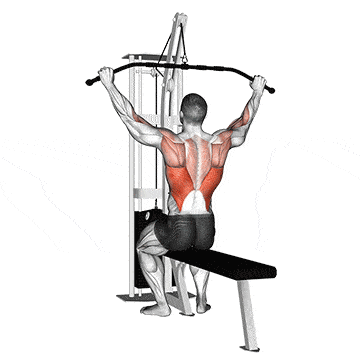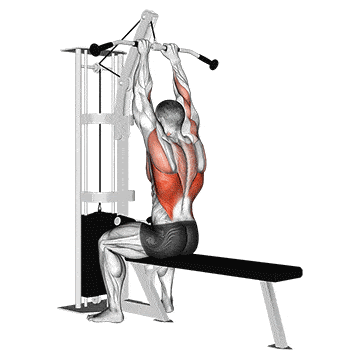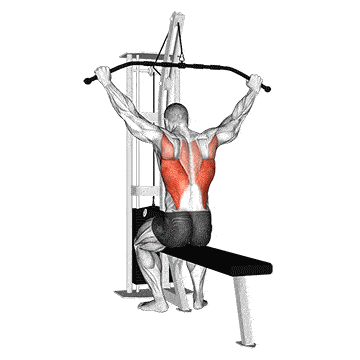18 de October de 2021
How To Do Lat Pulldowns In Strength Training
Quick overview: The lat pulldown is one of the best exercises to get a broad back. With a multitude of grip options and intensity techniques, the lat pulldown is extremely effective and an excellent alternative to pull-ups and rows. Beginners who still have problems with pull-ups build up a certain basic strength with the lat pulldown – advanced bodybuilders, on the other hand, can use the lat pulldown to develop details in the back.
Benefits of Doing Lat Pulldowns
Since the pull-downs are performed on the training machine, the risk of injury is low, but still exists. Correct execution is therefore very important. With the lat pulldown, you have the opportunity to train your back and arm muscles. However, the arm muscles are only included in a supportive manner.
For beginners as mentioned before, the lat pull-up is easier than the normal pull-up because you don’t have to use your own body weight. However, even experienced athletes gain numerous benefits and are recommended to train the latissimus, as the muscle is stressed differently here than with the classic pull-up.
Because the lat pulldown machine allows you to attach a wide variety of handles and training bars, you can train in different positions. For example, there is the parallel grip or the V-grip and you have the option of making a narrow or wide grip. Depending on which type of exercise you are doing, you can train the different muscles in your back.
In addition, the most common exercises are performed either towards the neck or towards the chest. Depending on whether you decide on a narrow or wide grip, you can specifically train the desired muscle area in the back.
Which Muscles Lat Pulldowns Target
The lat pulldown mainly trains the broad back muscle (musculus latissiums dorsi) and the lower fibers of the hood muscle (musculus trapezius pars ascendens). The large and small rhomboid muscles (musculus rhomboideus minor et major) and the large round muscle (musculus teres major) are also heavily used.
Lat Pulldown Variations
In the beginning, it is important that you choose the weight you want to use realistically and according to your possibilities. It is the same with the repetitions and the sets. If you use too much weight too quickly, it can lead to injuries and severe muscle soreness. Because you have so many different exercise variations with the lat pulldown, it makes sense to subdivide them.
-
Lat Pulldown Wide To The Chest
With the wide lat pulldown towards the chest, the latissimus on the side of the back is strengthened. In addition, this variant is comparatively the most effective and at the same time, the joints in the shoulders are spared. The muscles of the shoulder blades and your back shoulders are also used. Then there are the arm muscles.

To start the exercise, sit down on the seat of the training device facing the machine. Then you place your legs in the cushion, which is provided for it. It is important that you get a firm hold with your legs so that the weight cannot pull you upwards while doing the exercise.
Now you grab the broad bar after the curve from above and bring your back into a light hollow back. You bend your arms. Then you lean back a little and take a deep breath. Now you exhale and start pulling the bar towards your chest. It is important that you do not lean back to simplify it, but use your back and arm muscles.
As soon as you have pulled the bar towards your chest and it touches it, the first part of the exercise is done. Then you can slowly begin to perform the upward movement. It should be noted that you don’t let the weight rush down by itself, but work against the pull of the weight, otherwise you can hurt yourself.
-
Lat Pulldown Close To The Chest
The lats are much less challenged in the tight chest pull-down than in the wide version. Here the focus is more on the brachial arm muscle. However, muscles such as the latissimus or the trapezius are challenged. In addition, biceps and shoulder muscles are also used.

In this version, you sit down on the bench just like the broad lat pulldown. Now you grab the bar from above about hip-width. Now you can start pulling the bar down. At about neck level you have done the first part of the exercise again. To complete the exercise, you work against the weight again and slowly lower it.
-
Lat Pull Wide To The Neck
Just like with the wide lat pulldown to the chest, the latissimus is ideally trained here. The trapezius muscle is also stressed. In addition, the biceps, rear shoulder muscles, and the muscles near the shoulder blades are also used. A disadvantage of this exercise, however, is that you could overload or injure your joints.

Like the other lat pulldown exercises, with the lat pulldown wide to the neck you sit down with your face to the machine. You also place your legs in the cushion provided for this purpose. Now you tense your arm, back, and abdominal muscles and bring your back into a slightly hollow position.
Now you grab the bar again after the curve and lean your head a little forward so that you can lead the bar past it without any problems. Then pull the bar forcefully towards the neck, but not with momentum. The tow bar should not touch the neck. You should stop it shortly before that and hold it there for a moment.
You must make sure that your back remains under tension before you start the upward movement and that you are working against the weight again to avoid being pulled up. It is also important that you do not fully stretch your arms so as not to overload your elbows.
Common Mistakes When Doing Lat Pulldowns
When performing the lat pulldowns exercises, typical sources of error are abandoning body tension and switching to a hunched back and pulling the pulldown bar too deep down to the shoulders at the end of the pulling phase, as well as fully extending the arms at the end of each repetition. These mistakes can lead to injuries to the back, shoulder, and elbow joints and should therefore be avoided.
Conclusions
It is crucial to select a weight that will allow you to have complete control over your body throughout the exercise. Always pay close attention to your body when performing any exercise, and stop if you feel pain or discomfort. Include proper warm-ups, rest, and nutrition into your exercise program for continual progress and body strength. To measure your exercises you can use a vbt device. The outcome of your workouts ultimately depends on how you recover from them. If you have any questions, don’t hesitate to ask! Leave a comment or contact us here.

